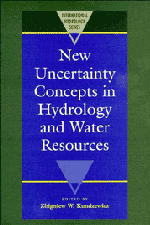Book contents
- Frontmatter
- Contents
- List of Authors
- Preface
- I INTRODUCTION
- II FACETS OF UNCERTAINTY
- III NOVEL APPROACHES TO UNCERTAINTY: FRACTALS, FUZZY SETS AND PATTERN RECOGNITION, NON-PARAMETRIC METHODS
- IV RANDOM FIELDS
- V TIME SERIES AND STOCHASTIC PROCESSES
- VI RISK, RELIABILITY AND RELATED CRITERIA
- 1 Stochastic approach to non-point pollution of surface waters
- 2 Statistically safe sets methodology for optimal management of reservoirs in risk situations
- 3 Risk assessment in control of reservoir systems
- 4 Reliability-related criteria in water supply system studies
- 5 Reliability analysis of reservoir operation
1 - Stochastic approach to non-point pollution of surface waters
Published online by Cambridge University Press: 07 May 2010
- Frontmatter
- Contents
- List of Authors
- Preface
- I INTRODUCTION
- II FACETS OF UNCERTAINTY
- III NOVEL APPROACHES TO UNCERTAINTY: FRACTALS, FUZZY SETS AND PATTERN RECOGNITION, NON-PARAMETRIC METHODS
- IV RANDOM FIELDS
- V TIME SERIES AND STOCHASTIC PROCESSES
- VI RISK, RELIABILITY AND RELATED CRITERIA
- 1 Stochastic approach to non-point pollution of surface waters
- 2 Statistically safe sets methodology for optimal management of reservoirs in risk situations
- 3 Risk assessment in control of reservoir systems
- 4 Reliability-related criteria in water supply system studies
- 5 Reliability analysis of reservoir operation
Summary
ABSTRACT An outline of conceptual stochastic models for describing the concentration of pollutants from non-point sources in a river is presented. Pollutants are assumed to have originated from agricultural fields and to have reached a river attached to suspensa eroded from a watershed. The model consists of three parts: a module describing runoff of pollutants from the land into the river, a module for transport in the river, and a decision module which quantifies the consequences of the river pollution. The model serves as a guide for structuring an experimental programme being conducted at the University of Karlsruhe.
INTRODUCTION
Surface runoff from fertilized fields is an important source of pollution of surface waters. In order to remedy a potentially critical pollution, it is necessary to quantify the amount of pollutants carried by the waters. A quantification of the pollutant load must include random aspects, as crops, agricultural chemicals used and hydrological variables vary in space and time. A stochastic approach requires a long term simulation, which is feasible only if the physical situation is suitably simplified. That is, only a class of pollutants is typically considered. One can distinguish three basic classes, that is substances that adhere to the soil particles (e.g. phosphates), well soluble substances that act like simple tracers (e.g. NaCl), and those that interact chemically with the soil and with other substances (e.g. nitrates).
Further simplifications depend on the time and space scales of the model.
- Type
- Chapter
- Information
- New Uncertainty Concepts in Hydrology and Water Resources , pp. 273 - 283Publisher: Cambridge University PressPrint publication year: 1995
- 1
- Cited by



